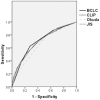Comparing staging systems for predicting prognosis and survival in patients with hepatocellular carcinoma in Egypt
- PMID: 24603710
- PMCID: PMC3946382
- DOI: 10.1371/journal.pone.0090929
Comparing staging systems for predicting prognosis and survival in patients with hepatocellular carcinoma in Egypt
Abstract
Introduction: Several hepatocellular carcinoma (HCC) staging systems are available. Although the European Association for Study of Liver Diseases (EASL) and American Association for the Study of Liver Diseases (AASLD) recommended the use of Barcelona Clinic Liver Cancer (BCLC), many studies in different populations revealed heterogeneous results. The aim of this study was to compare different staging systems for predicting prognosis and survival, and for stratifying HCC patients for treatment at a national referral centre for liver disease in Egypt.
Methods: 2000 Patients were included in this study. Baseline demographic, clinical, laboratory, and radiological data were determined at diagnosis. Patients were stratified using the Okuda, BCLC, Cancer of the Liver Italian Program (CLIP), and Japan Integrated Staging (JIS). Patients' survival in different stages within each staging system and the validity of the system in predicting survival were compared.
Results: The overall survival was 15 months. The 1-, 2-, 3- and 4-year survival of the entire cohort was 56%, 34%, 25% and 15% respectively. The presence of ascites, multiple focal lesions, large tumour size >5 cm, portal vein thrombosis, extra-hepatic spread, AFP≥200 ng/ml and poor Child score were independent predictors of survival (p<0.001). All staging systems were significant in determining overall survival in univariate and multivariate analyses. BCLC was the most predictive staging system for the whole cohort (p<0.001). Among the subgroup of patients offered potentially curative therapy, BCLC was the most informative system in predicting patient survival (p<0.001). For patients with advanced HCC not amenable for specific therapy, CLIP was the best staging system for predicting prognosis (p<0.001).
Conclusion: BCLC staging system provided the best prognostic stratification for HCC patients. However, CLIP score has the highest stratification ability in patients with advanced HCC highlighting the importance of including AFP in best staging system.
Conflict of interest statement
Figures




References
-
- El-Serag HB (2011) Current concepts Hepatocellular carcinoma: review. N Engl J Med 365: 1118–1127. - PubMed
-
- Ferlay J, Shin HR, Bray F, Forman D, Mathers C, et al. (2010) Estimates of worldwide burden of cancer in 2008: GLOBOCAN 2008. Int. J. Cancer 127: 2893–2917. - PubMed
-
- GLOBOCAN 2008 v1.2, Cancer Incidence, Mortality, Prevalence and Disability-adjusted life years (DALYs) Worldwide: IARC: International Agency for Research on Cancer; Available: http://globocan.iarc.fr.Accessed 2013 Nov 13.
-
- Marrero JA, Kudo M, Bronowicki J (2010) The Challenge of Prognosis and Staging for Hepatocellular Carcinoma. Oncologist (suppl 4): 23–33. - PubMed
Publication types
MeSH terms
LinkOut - more resources
Full Text Sources
Other Literature Sources
Medical

